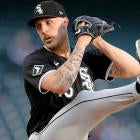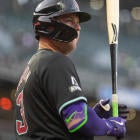
Throwing harder is better, especially during the spring, when most pitchers are still rounding up. It's not everything, but you'd rather see higher velocity readings than lower. Here's what stood out this week:
I've written about Bailey Ober a few times this spring already, but it's worth highlighting again for this last spring roundup, because there's a lot of upside here, seemingly. He earned high praise from Bryce Harper after an early spring appearance during which he hit 94.8 mph, the hardest pitch of Ober's career. Ober is up about 1.5-2 mph from last year's 91.3 mph average, and he was already a strikeout-per-inning guy before this; he's at 16 in 10 innings this spring. No, Bailey Ober isn't going to go out and pitch like Spencer Strider. But he gives hitters fits with his command of four pitches and the incredible extension he generates with his 6-foot-9 stature, and if he can sustain this velocity jump, Ober might have another level to reach after his breakout 2023.
When Cole Irvin showed up to camp throwing harder than he ever had before, I was intrigued. He was already a useful Fantasy pitcher in the past as a command-and-control oriented soft-tosser, and injuries had seemingly locked him into spot in the Orioles rotation, so I was willing to spend a late-round pick here and there on a potential mini-breakout. But the results have been pretty awful so far this spring, with 10 runs and 10 walks in 12.1 innings of work, with just eight strikeouts. It could be that Irvin is just working on things, but Irvin's velocity was back down to 2023 levels in his most recent start this week and he still walked five in 3.2 innings. I don't want to give up on any pitcher based on a bad spring start or two, but given that my interest level in Irvin was never all that high to begin with, it's back down where it was before the spring now.
Now Jack Flaherty is someone I think might actually be worth getting excited about. He's been hitting 97 and averaging between 94 and 95 mph, and he's been dominant this spring, striking out 35% of opposing hitters while allowing only nine hits and four walks in 13.2 innings. Does this automatically mean he's back to his 2019 ace levels again just because his velocity is? Of course not, nothing is ever that simple. But I had little interest in Flaherty coming into the spring, and now I have enough to move him into the top 70 of my pitcher rankings, nestled right between Reid Detmers and Luis Severino, two of my other favorite sleepers.
Mason Miller had plenty of velocity as a starter, averaging 98.3 mph with his fastball, but we were hoping he might have an extra gear in his move to the bullpen, and that's what we've seen this spring. He's hitting 103 and has averaged 99.9 mph with his fastball, and he's fired six shutout innings with nine strikeouts so far. The Athletics haven't anointed him the closer yet, and they may not do so until he shows he can do it in high-leverage situations. But my bet is he's already the closer, and we'll see that very early on in the season – and I legitimately think he might be one of the best relievers in baseball already.
Jackson Jobe won't be in the Tigers rotation, and he probably isn't next in line, either. But life finds a way, and it tends to find a way for uber-talented young pitchers who are literally the hardest throwing pitchers in spring training than any other pitcher. It was only one short outing in front of the Statcast cameras, but Jobe averaged 100.2 mph in that lone outing, a couple ticks up from where he's been for most of his pro career. Jobe is a consensus top-25 prospect who has struck out 28% of opposing hitters as a pro even before this apparent velocity jump. There's a chance he's just the best pitching prospect in baseball if this sticks, and we're going to see him at some point this season if he stays healthy. Remember that name.






















